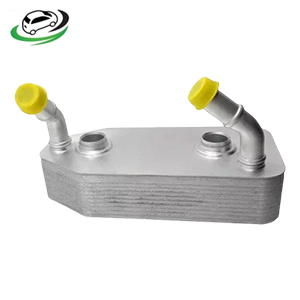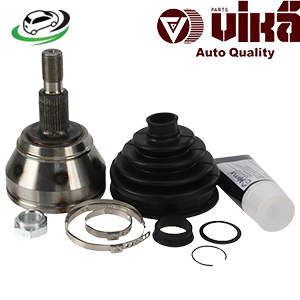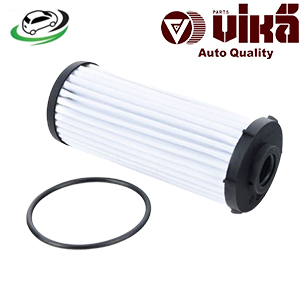-11%
Get Transmission Filter Audi 8S TTRS Quattro 2.5T / Audi RS3 8V (2018+) 2.5T 0BH325183B
The transmission filter is a crucial component in the automatic transmission system of a vehicle. It plays a significant role in maintaining the cleanliness of the transmission fluid, which is essential for the smooth operation and longevity of the transmission. This detailed guide explores the function, design, maintenance, and common issues related to the transmission filter.
1. Purpose and Function of the Transmission Filter
The primary function of the transmission filter is to remove contaminants from the transmission fluid. These contaminants can include metal particles, debris, and other impurities that can cause damage to the transmission if not filtered out.
1.1. Filtering Contaminants
- Metal Shavings: During normal operation, transmission components such as gears and clutches generate small metal particles. The filter captures these particles to prevent them from circulating in the fluid and causing wear or damage.
- Debris and Dirt: Dirt, dust, and other debris can enter the transmission system through various pathways, including the air intake or from road conditions. The filter ensures that these contaminants are removed from the fluid before it reaches critical transmission components.
- Wear Particles: Over time, the transmission’s internal parts wear out, producing additional particles that can be harmful if allowed to remain in the fluid. The filter captures these particles, helping to maintain fluid cleanliness and transmission health.
1.2. Ensuring Proper Fluid Flow
- Preventing Clogging: By removing contaminants, the filter helps prevent clogging of the transmission fluid passages and channels. Clogged passages can lead to poor fluid flow, which can affect the transmission’s performance and efficiency.
- Maintaining Fluid Pressure: A clean filter helps maintain proper fluid pressure within the transmission system. Adequate fluid pressure is essential for the smooth operation of the transmission’s hydraulic components and for achieving seamless gear shifts.
2. Design and Structure of the Transmission Filter
The design of the transmission filter varies depending on the vehicle make and model, but it generally includes the following components:
2.1. Filter Types
- Internal Filters: Many automatic transmissions use an internal filter, which is located within the transmission pan. This filter is usually attached to the bottom of the transmission or inside the pan itself.
- External Filters: Some vehicles are equipped with external transmission filters, which are mounted outside the transmission and are connected to the transmission fluid lines. External filters are generally easier to access and replace compared to internal filters.
2.2. Filter Components
- Filter Media: The filter media is the material used to trap and hold contaminants. It can be made from various materials, including paper, cloth, or synthetic materials. The media is designed to provide a high level of filtration while allowing adequate fluid flow.
- Filter Housing: The filter housing encloses the filter media and provides a structural framework for the filter. It typically includes inlet and outlet ports for the transmission fluid to flow through the filter.
- O-Rings and Gaskets: O-rings and gaskets are used to seal the filter and prevent leaks. They ensure that the fluid flows through the filter media and not around it, maintaining the effectiveness of the filtration process.
2.3. Filter Placement
- Internal Filters: Internal filters are typically located in the transmission pan, which requires the pan to be removed for filter access. Internal filters are often designed to be replaced during a transmission fluid change.
- External Filters: External filters are mounted on the transmission or nearby and are accessible without removing the transmission pan. They are usually replaced during routine maintenance or fluid changes.
3. Maintenance and Replacement of the Transmission Filter
Regular maintenance and timely replacement of the transmission filter are crucial for ensuring the health and performance of the transmission.
3.1. Recommended Replacement Intervals
- Manufacturer’s Guidelines: The recommended replacement interval for the transmission filter varies by manufacturer and vehicle model. It is essential to refer to the vehicle’s owner’s manual or service guide for specific recommendations.
- General Recommendations: As a general rule, the transmission filter should be replaced every 30,000 to 60,000 miles, depending on driving conditions and the type of transmission. Severe driving conditions, such as towing or stop-and-go traffic, may require more frequent replacements.
3.2. Signs That the Filter Needs Replacement
- Slipping Gears: If the transmission begins to slip or has difficulty shifting gears, it may indicate that the filter is clogged and needs replacement.
- Erratic Shifting: Noticeable changes in the transmission’s shifting patterns, such as hard or delayed shifts, can be a sign that the filter is not effectively removing contaminants.
- Strange Noises: Unusual noises, such as whining or grinding sounds, may be caused by contaminated transmission fluid resulting from a clogged filter.
- Fluid Contamination: If the transmission fluid appears dirty, discolored, or has a burnt odor, it may indicate that the filter is no longer effectively filtering contaminants.
3.3. Replacement Procedure
- Internal Filters: Replacing an internal filter involves draining the transmission fluid, removing the transmission pan, and replacing the filter. After installing the new filter, the transmission pan is reattached, and fresh fluid is added.
- External Filters: Replacing an external filter is typically a simpler process. The old filter is removed, and the new filter is installed in its place. The transmission fluid level is then checked and adjusted as needed.
4. Common Issues with the Transmission Filter
While the transmission filter is a relatively simple component, it can experience several issues that affect its performance and the transmission’s health.
4.1. Clogging and Blockage
- Debris Accumulation: Over time, the filter media can become clogged with contaminants, reducing its effectiveness. Clogging can lead to restricted fluid flow and poor transmission performance.
- Sediment Build-Up: Sediment and sludge can accumulate in the filter, especially if the transmission fluid has not been changed regularly. This build-up can cause the filter to become less effective.
4.2. Leaks
- Seal Failures: O-rings and gaskets used to seal the filter can deteriorate over time, leading to leaks. Leaks can result in low transmission fluid levels and potential damage to the transmission.
- Housing Cracks: Cracks or damage to the filter housing can also lead to leaks and reduced filtration efficiency.
4.3. Contaminated Fluid
- Fluid Degradation: If the transmission filter is not replaced regularly, contaminants can accumulate in the transmission fluid, causing it to degrade. This can result in poor performance and increased wear on transmission components.
5. The Role of the Transmission Filter in Vehicle Performance
The transmission filter plays a crucial role in maintaining the performance and longevity of the automatic transmission. By ensuring that the transmission fluid remains clean and free of contaminants, the filter helps:
- Improve Shifting Performance: A clean filter supports smooth and precise gear shifts, enhancing the overall driving experience.
- Extend Transmission Life: By preventing contaminants from causing wear and damage, the filter helps extend the life of the transmission components.
- Prevent Transmission Failures: Regular maintenance and timely replacement of the filter can prevent costly transmission failures and repairs.
6. Advances in Transmission Filtration Technology
Modern vehicles often feature advanced filtration technologies that enhance the effectiveness of transmission filters:
- High-Efficiency Filter Media: Newer filter designs use advanced materials and technologies to provide better filtration and longer service intervals.
- Integrated Filtration Systems: Some vehicles have integrated filtration systems that combine multiple filters and cooling components to improve overall transmission health and performance.
- Monitoring Systems: Advanced vehicles may include sensors and monitoring systems that track the condition of the transmission fluid and filter, alerting the driver when maintenance is needed.
Follow us on Facebook for more parts.



